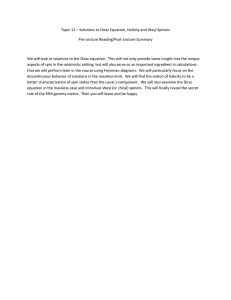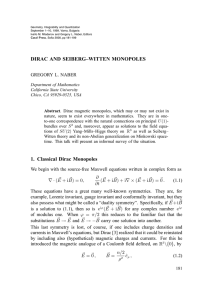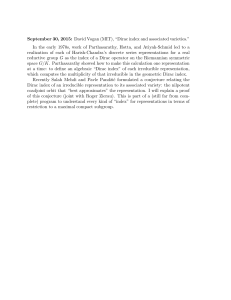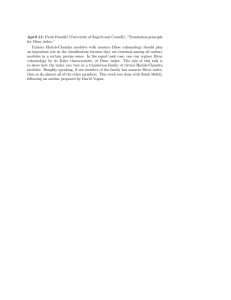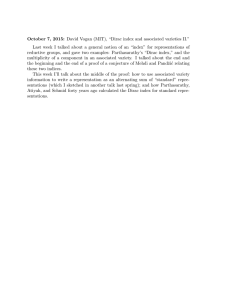the maxwell and quaternionic dirac equations under chiral
advertisement
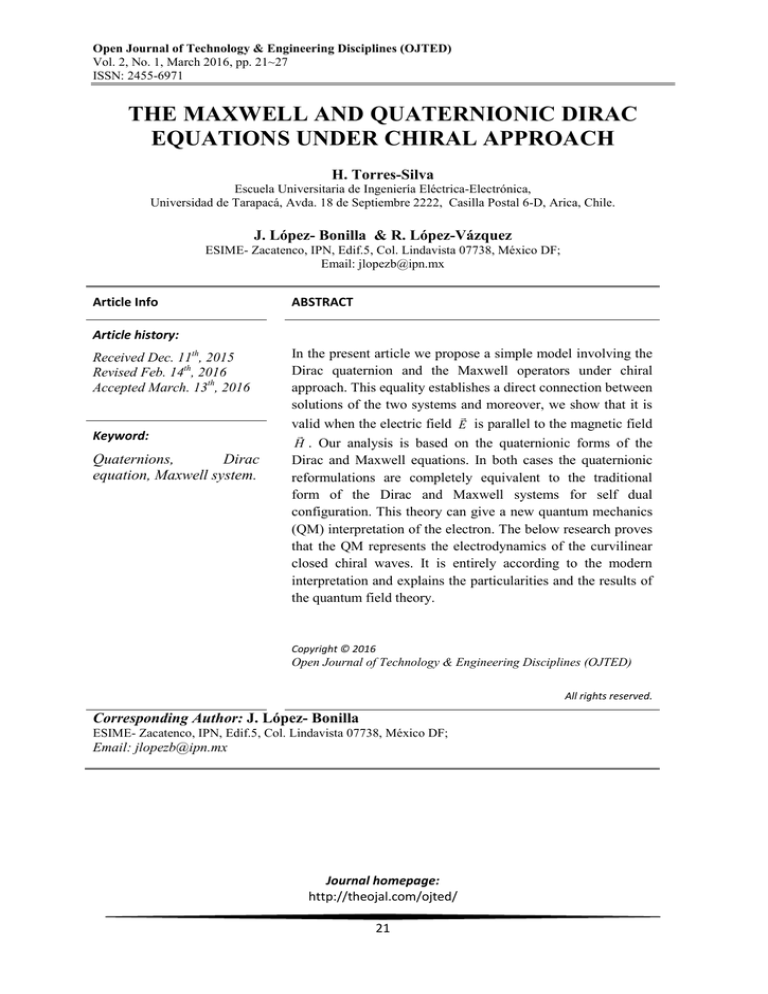
Open Journal of Technology & Engineering Disciplines (OJTED) Vol. 2, No. 1, March 2016, pp. 21~27 ISSN: 2455-6971 THE MAXWELL AND QUATERNIONIC DIRAC EQUATIONS UNDER CHIRAL APPROACH H. Torres-Silva Escuela Universitaria de Ingeniería Eléctrica-Electrónica, Universidad de Tarapacá, Avda. 18 de Septiembre 2222, Casilla Postal 6-D, Arica, Chile. J. López- Bonilla & R. López-Vázquez ESIME- Zacatenco, IPN, Edif.5, Col. Lindavista 07738, México DF; Email: jlopezb@ipn.mx Article Info ABSTRACT Article history: Received Dec. 11th, 2015 Revised Feb. 14th, 2016 Accepted March. 13th, 2016 Keyword: Quaternions, Dirac equation, Maxwell system. In the present article we propose a simple model involving the Dirac quaternion and the Maxwell operators under chiral approach. This equality establishes a direct connection between solutions of the two systems and moreover, we show that it is valid when the electric field E is parallel to the magnetic field H . Our analysis is based on the quaternionic forms of the Dirac and Maxwell equations. In both cases the quaternionic reformulations are completely equivalent to the traditional form of the Dirac and Maxwell systems for self dual configuration. This theory can give a new quantum mechanics (QM) interpretation of the electron. The below research proves that the QM represents the electrodynamics of the curvilinear closed chiral waves. It is entirely according to the modern interpretation and explains the particularities and the results of the quantum field theory. Copyright © 2016 Open Journal of Technology & Engineering Disciplines (OJTED) All rights reserved. Corresponding Author: J. López- Bonilla ESIME- Zacatenco, IPN, Edif.5, Col. Lindavista 07738, México DF; Email: jlopezb@ipn.mx Journal homepage: http://theojal.com/ojted/ 21 Open Journal of Technology & Engineering Disciplines (OJTED) Vol. 2, No. 1, March 2016, pp. 21~27 ISSN: 2455-6971 1. INTRODUCTION The relation between the two most important in mathematical physics first order systems of partial differential equations is among those topics which attract attention because of their general, even philosophical significance but at the same time do not offer much for the solution of particular problems concerning physical models. Here we explore the connection between the Maxwell and Dirac equations under the quaternionic formalism in different ways [1-9]. Solutions of the Maxwell’s system can be related to solutions of the Dirac equation through some connection [6-11]. Nevertheless, in spite of these significant efforts there remain some important conceptual questions. For example, what is the meaning of this close relation between the Maxwell system and the Dirac equation and how this relation is connected with the wave-particle dualism? In the present article we propose a simple equality involving the Dirac and Maxwell operators under chiral approach. This equality establishes a direct connection between solutions of the two systems and moreover, we show that it is valid when a quite natural relation between the frequency of the electromagnetic wave and the energy of the Dirac particle is fulfilled when the wave electric field is parallel to the magnetic field. Our analysis is based on the quaternionic form of the Dirac equation [7] and the quaternionic form of the Maxwell equations proposed in [8] (see also [9]). In both cases the quaternionic reformulation are completely equivalent to the traditional form of the Dirac equation. Quaternionic quantum mechanics has been investigated by Adler and others [1-11]; we will follow here a rather different approach than that of these references. It is interesting to note that the quaternionic wave function consists of scalar and vector components, hence the emerging equations can then describe scalar and vector particles, and the resulting equations would then mix the scalar and vector components. We anticipate that these particles could be the bosons and fermions, then one can in some respect unify KleinGordon and Dirac equations in a single equation. The spin of the particle shows up when the particle interacts with the photon field. 2. THE QUATERNIONIC DIRAC EQUATION The algebra of complex quaternions is denoted by H (C ) ; each complex quaternion q is of the form q k 0 qk i k , where qk C , i0 is the unit and ik 3 k 1, 2,3 are the quaternionic imaginary units: i02 i0 ik2 ; i0 ik ik i0 ik , k 1, 2,3 ; i1i2 i2 i1 i3 ; i2 i3 i3i2 i1 ; Journal homepage: http://theojal.com/ojted/ 22 i3i1 i1i3 i2 . Open Journal of Technology & Engineering Disciplines (OJTED) Vol. 2, No. 1, March 2016, pp. 21~27 ISSN: 2455-6971 The complex imaginary unit i commutes with ik , k 0,3 . We will use the vector representation of Vec(q ) q k 1 qk ik 3 complex q Sc(q) Vec(q) , quaternions: where Sc(q) q0 and , that is, each complex quaternion is a sum of its scalar part and its vector part. Complex vectors we identify with complex quaternions whose scalar part is equal to zero. In vector terms, the multiplication of two arbitrary complex quaternions q and b can be written as follows: 3 q b : qk bk C , qb q0b0 q b q b q0b b0 q , k 1 i1 q b : q1 b1 i2 q2 b2 i3 q3 C 3 . b3 If q b is not equal to zero the quaternion product is non-commutative and this property we use it in our paper. The presence of dot and vector products in the quaternion product is no coincidence since historically W. Gibbs introduced these two products by splitting the quaternion product and by taking q0 b0 0 [10]. Following [7], we consider the Dirac equation in its covariant form: 3 1 t k k i mc t , x 0 ; k 1 c for a wave function with a given energy we have t , x a x e , where a satisfies the i t i 3 equation k k k 1 c i mc a x 0 , 0 1 where we introduce the matrices and in chiral 0 2 representation with 2 1 , and are the Pauli matrices. , 0 1 0 i c Now we consider a particle described by the quaternionic wave function ( 0 , ) b . The Dirac’s momentum is defined as: i P ( E , p) , c (1) i c where P ( E, p) q ; here we propose a chiral quaternionic expression such that the quaternionic momentum eigenvalue problem can be written as: P i m0 c , Journal homepage: http://theojal.com/ojted/ 23 (2) Open Journal of Technology & Engineering Disciplines (OJTED) Vol. 2, No. 1, March 2016, pp. 21~27 ISSN: 2455-6971 which is in fact similar to Dirac equation [12]. The evolution of this equation is expressed by two equations: m c2 1 ( i 0 )0 0 , c t 0 ( m c2 i 0 ) ic t (3) , (4) which satisfy the Dirac equation. Using 0 the identity 0 and operating eq. (4) with , we have m c2 1 ( i 0 ) 0 . We deduce from Eq. (3): 2 c t 20 m c2 m c2 1 ( i 0 )( i 0 )0 0 . 2 t c t (5) Now if we define c 0 , from (3) and (4) and using the identity ic c( )( we obtain 0 ( m c2 m c2 1 i 0 ) c( )( ) ( i 0 )0 0 t c t So this expression can be reduced to: 0 mc 1 0 i 0 0 0 , c t (6) which is equivalent to spinor representation of ordinary Dirac’s equation in quantum mechanics [13]. We put mc 1 i 0 and squaring this equation, then: c t m mc 1 2 20 2(i 0 ) 0 ( 0 ) 2 0 0 , 2 2 0 t c t (7) m mc 1 2 20 2(ic 0 ) 0 ( 0 ) 2 0 0 , 2 2 0 c t (8) these forms of Dirac equation exhibit clearly the wave nature of the electron which can be compared with the Klein-Gordon equation: Journal homepage: http://theojal.com/ojted/ 24 Open Journal of Technology & Engineering Disciplines (OJTED) Vol. 2, No. 1, March 2016, pp. 21~27 ISSN: 2455-6971 mc 1 2 2 ( 0 ) 2 0 . c 2 t 2 (9) Now we consider the mapping similar to gauge transformation ' A and 0 ' 0 1 c t ; under these transformations the eqs. (3) and (4) give ' ( i 0 ' ( m c2 i 0 ) ' ic ' , t m0 c 2 A t )0 ' 0 and thus they are invariant under these transformations. This i c transformation is similar to Lorenz gauge of electromagnetism if we put b A ( V , A) and i P ( E, p) q and eqs. (3) and (4) are given by: c m c2 1 A ( i 0 )V 0 , c t V ( (10) m c2 i 0 ) A ic A , t (11) where A and are the complex vector magnetic potential and the scalar electric potential, respectively. Defining m c2 ( i 0 ) , t * t then eq. (10) corresponds to a gauge like Lorenz gauge: A 1 V 0, c t * (12) and eq. (11) is the instanton solution for the electromagnetism with E parallel to B (selfdual configuration): V A E ic A icB . t * (13) Now we analyze the connection between eq. (7) and the wave equation for the electric field E . Let us write c 0 c A V so: m mc 1 2 V 2V 2(i 0 ) V ( 0 ) 2 V 0 , t c 2 t 2 Journal homepage: http://theojal.com/ojted/ 25 (14) Open Journal of Technology & Engineering Disciplines (OJTED) Vol. 2, No. 1, March 2016, pp. 21~27 ISSN: 2455-6971 this expression is equivalent to simplified to c ( m mc c 2 A 2 c A 2(i 0 ) c A ( 0 )2 c A 0 , which is 2 2 t c t m mc 1 2 A 2 A 2i 0 A ( 0 ) 2 A) 0 , t c 2 t 2 and due to and c 0 , we deduce: m mc 1 2 A 2 A 2i 0 A ( 0 ) 2 A 0 . t c 2 t 2 Taking of (14) and (15) of (15) and summing we have: t m mc 1 2 E 2 E 2i 0 E ( 0 ) 2 E 0 , 2 2 t c t (16) which is the wave equation of the electric field if we consider 2i ( m0 c ) 2 E 0 ; here the term ( m0 c )2 E 0 m0 and is transformed taking the divergence of both sides, so using the Gauss law we obtain 2 ( m0 c )2 0 as a wave equation for the charge density and for the electric field, therefore: 1 2 E 2 E E E 0, 2 2 t c t (17) where the conductivity depends on the mass. Hence the magnetic field B A inside a conducting media behaves like a particle with mass defined as 2i m0 [14]. Our results can be compared with expressions founded in [13], which use P m0 c . Here, we are taking into account the true non-commutative nature of the quaternion equation P i m0 c . 3. CONCLUSION By adopting the quaternionic quantum mechanics, namely, the quaternionic Dirac equation, we arrived at a dissipative or generalized Klein-Gordon equation with a particle spin. The main result of this paper is that the Dirac equation has a deep connection with the Maxwell’s equation under the chiral approach. The suggested theory is a new quantum mechanics interpretation, if we consider the instanton solution for the electromagnetic field E icB , that is, self-dual solutions possess trivial energy-momentum properties, and the desired free field configurations are obtainable as superposition of self-dual and anti-selfdual constituents. Journal homepage: http://theojal.com/ojted/ 26 Open Journal of Technology & Engineering Disciplines (OJTED) Vol. 2, No. 1, March 2016, pp. 21~27 ISSN: 2455-6971 REFERENCES [1] S. L. Adler, Quaternionic Quantum Mechanics and Quantum Fields, Oxford University Press (1995) [2] B. Carvajal, I. Guerrero, J. López-Bonilla, Quaternions, 2 x 2 complex matrices, and Lorentz transformations, Bibechana (Nepal) 12 (2015) 30-34 [3] J. López-Bonilla, L. Rosales, A. Zúñiga S., Dirac matrices via quaternions, J. Sci. Res. (India) 53 (2009) 253-255 [4] K. Gürlebeck, W. Sprößig, Quaternionic analysis and elliptic boundary value problems, Akademie-Verlag (1989) [5] K. Imaeda, A new formulation of classical electrodynamics, Nuovo Cimento B32 No. 1 (1976) 138-162 [6] M. Gogberashvili, Octonionic version of Dirac equations, Int. J. of Mod. Phys. A 21, No. 17 (2006) 3513-3523 [7] V.V. Kravchenko V. Kravchenko, On the relation between the Maxwell system and the Dirac equation, WSEAS Transaction on Systems 1, No. 2 (2002) 115-118 [8] I. Yu. Krivsky, V.M. Simulik, Unitary connection in Maxwell-Dirac isomorphism and the Clifford algebra, Advances in Applied Clifford Algebras 6, No. 2 (1996) 249-259 [9] A. Lakhtakia, Beltrami fields in chiral media, World Scientific (1994) [10] A. Bork, Vectors versus quaternions, Am. J. Phys. 34, No. 3 (1966) 202 -211 [11] H. Torres-Silva, Chiral electrodynamics: Base for a unified electromagnetism Gravitation, Intellectual Creation Project, 1988-1999, Internal Publication UTA (2000) [12] D. Griffiths, Introduction to elementary particles, John Wiley, New York (1987) [13] A. Arbab, A new wave equation of the electron, J. of Modern Physics 2 (2011) 10121016 [14] A. de Assis, H. Torres-Silva, G. T. Marklund, Convective Schrödinger Equation: Insights on the Potential Energy’s Role to Wave Particle Decay, Jour. of Electromagnetic Analysis and Applications 7 (2015) 225-232 Journal homepage: http://theojal.com/ojted/ 27

